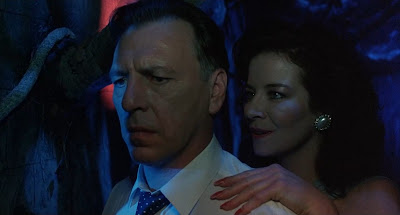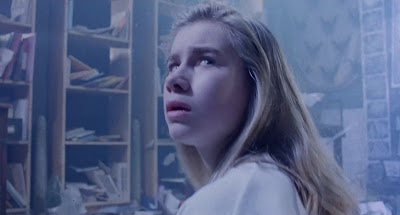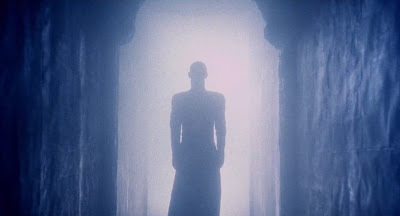 |
| Julia (Clare Higgins) tempts the occult- obsessed Dr. Channard (Kenneth Cranham). |
Release Date: Sept. 9, 1988. Running Time: 93 minutes (theatrical), 99 minutes (unrated). Screenplay by: Peter Atkins. Based on the novella, The Hellbound Heart, by Clive Barker. Directed by: Tony Randel. Produced by: Christopher Figg, David Barron.
THE PLOT:
After the bloodbath at her father's house, Kirsty (Ashley Laurence) is taken to the Channard Institute, a psychiatric hospital. She pleads with the investigating detective to burn the mattress where her stepmother, Julia (Clare Higgins), had died. Kirsty insists that the mattress could allow Julia to return the same way her evil uncle Frank did, but her talk of hell and demons is dismissed as ravings and hallucinations.
But she's not dismissed by Dr. Channard (Kenneth Cranham). He has harbored a lifelong fascination with the occult, including the Lament Configuration. He uses his connections to secure both the mattress and the puzzle box. With a hospital full of patients at his disposal, it isn't long before he has brought Julia back from the dead.
One of the patients at the Institute is Tiffany (Imogen Boorman), a young girl who spends all her time compulsively solving puzzles. Channard uses her to open the Lament Configuration. Then, with Julia as his guide, he walks straight into hell, determined to unlock its secrets.
Kirsty follows, on a mission of her own: to find and rescue her murdered father!
 |
| Tiffany (Imogen Boorman) solves the puzzle box - and opens the door to hell! |
CHARACTERS:
Julia: Ironically, she seems almost more human than at the end of the first film. Not in any positive way, mind you, but because she seems consumed by her old resentments. She toys sadistically with Kirsty, who never even gave her a chance to be anything other than the "wicked stepmother." She seizes that title along with "evil queen" for herself, and her interactions with Kirsty - half teasing, half vicious - are similar to the Cenobites... only unlike them, her cruelty is deliberate. Actress Clare Higgins is once again the film's greatest asset, and I don't think the series' quality ever recovered from her decision to make this her final entry.
Kirsty: I don't think Kirsty particularly works as a character in this movie. She has no self-preservation instincts, telling anyone who will listen about the demons she saw even when this (predictably) gets her taken to a mental hospital. Her bond with Tiffany might have provided an emotional throughline... except that this receives little screen time, being more assumed by the script than demonstrated. I will say that a scene in the second half that sees Kirsty coming face-to-face with her vile uncle Frank features some excellent acting from Ashley Laurence. Unfortunately, outside of this moment, Kirsty never feels particularly connected to the rest of the movie, which is more centered around Channard and Tiffany than around her.
Dr. Channard: There are two versions of Channard: the fully human one of the first half and a version that's been transformed within the labyrinth. It's the human Channard who is the scarier: Clinical to the point of being emotionless, but also consumed with an occult obsession that leads him to horrific acts, committed solely to satisfy his hunger "to know." He uses one delusional patient as a sacrifice, letting the man's blood draw Julia back to life. He sacrifices more patients to allow her to recover the thin veneer of humanity that is her skin. Finally, he offers up Tiffany as a sacrifice to the Cenobites, counting on her both to solve the box and to appease the demons - though this doesn't quite go according to plan.
Frank: My pick for the movie's best scene is the one in which Kirsty finds Frank in his own personal hell. Sean Chapman has thankfully been allowed to deliver his own lines rather than being overdubbed, and as a result Frank feels more fully realized. He's vicious, and the fate he has in mind for Kirsty would make the Cenobites' attentions seem almost appealing by comparison, but Chapman brings in other notes: frustration, anger, a sense of misplaced victimhood, and ridiculous overconfidence. It's this last that is his undoing, as Frank never considers that the power dynamics have shifted in his absence.
Tiffany: One of Dr. Channard's patients, young Tiffany spends all her time completing puzzles. Channard's assistant, Kyle (William Hope) muses that the puzzles may be her way of trying to resolve some trauma. In reality, Channard's obsession is the source of her trauma, which is divulged via flashbacks/visions once she passes through to the labyrinth.
Pinhead: After a recap, the new material begins with his origin story, as a World War I officer who sought out and opened the box for reasons that would be divulged in the third movie. His military background may explain the reserve and control that the other Cenobites lack. The female Cenobite is all set to descend on Tiffany, but Pinhead refuses because that would violate the rules. "It is not hands that call us. It is desire!" He also doesn't lie (no, not even in the first film - His deal with Kirsty was a very provisional "maybe"). When Kirsty refuses to believe that her father is unreachable, he allows her to "explore," to find out the truth for herself - probably in part to increase her despair when she fails to find him.
 |
| The Labyrinth, with the dark god Leviathan at its center. |
BUILDING THE MYTHOLOGY:
Hellbound: Hellraiser II is regularly regarded as the best of the Hellraiser sequels. The acting ranges from acceptable to very good. There's a unified visual style which complements the original film while also pushing the tone from horror into the realm of dark fantasy. The scenes in the labyrinth greatly build the series' mythology, establishing much of the hierarchy of this hell - from Leviathan, the dark god of the Labyrinth, to the creation of the Cenobites from human beings.
The movie introduces a psychological element to the torments endured by the box's victims. In the first film, we saw Frank savaged with chains... and then (in best Galaxy Quest voice) exploded. In this movie, physical pain is largely reserved for the real world, through the acts perpetrated by Channard and Julia before the box is opened. In the labyrinth, victims are punished in ways that strike at an emotional level.
Immediately before Kirsty's first encounter with the Cenobites, the Labyrinth delivers its first torture: Her old bedroom, a representation of the happy life she had with her parents. She smiles at her mother's picture... only to watch in horror, first as blood seeps from her old trappings, and then as her mother's beloved visage is replaced by Julia's hated one. When she finds Frank, he's suffering his own torment: Not chains or fire, but beautiful women on beds, whose forms vanish the instant he approaches, constantly inflaming his desires but never satisfying them.
 |
| Kirsty enters a nightmare version of her father's house, one of the few scenes in which she's an actual character. |
THE TROUBLE WITH KIRSTY:
The movie's first half is excellent. It builds steadily, first to Julia's return and then to the opening of the box. Up to this point, the threads work together. Kirsty's story alerts Channard that the focus of his obsession is in reach. Channard uses his connections to secure the mattress, then uses his patients to bring back and restore Julia. He also uses Tiffany to open the box, and with it the gates to hell. Then Julia, Channard, Tiffany, and Kirsty all pass through those doors, each in pursuit of a different goal. All of this feels unified; each character is searching for something, and their actions directly impact the other threads.
That unity fractures the instant the action shifts to the labyrinth. Some good set pieces disguise the problem for a while: Kirsty's old room, her encounter with the Cenobites, the scene with Frank. Gradually, however, it becomes clear that all of these scenes are about tying up the loose ends of the first film. Kirsty isn't really a part of the sequel's story at all.
There are two problems at play. The first, smaller issue was caused by the loss of actor Andrew Robinson, who had played her father in the first film. I've read differing reasons for why he rejected the role: dislike of the script, a role that was little more than a cameo, a lowball financial offer. It could well have been all three! In any event, the refusal appears to have come too late for the Page One rewrite that was needed to compensate. As a result, Kirsty's story feels incomplete, her quest not so much ending as being abandoned.
Even had Robinson come back, it would not have helped the larger problem: Kirsty's goals and emotional journey have no connection with this movie's own story. The final Act leaves her with no goal of her own. She's just left to act as Tiffany's protector; even at the climax, the real focus is not on her but instead on Channard and Tiffany.
As writer Pete Atkins has noted, Larry Cotton was a decent man, and there's no reason to believe he's in any form of hell. Perhaps it would have worked better had Kirsty been focused Julia - first the fear of her return, and then determination to destroy the woman who destroyed her family. That might have tied her more completely to the sequel's story, with Julia becoming her "white whale," a focus for her anger (which might, in turn, have given her a genuine dark impulse to draw the Cenobites to her).
As it stands, there's one thread too many in this film - and that redundant thread is Kirsty's. Since she's been presented as the movie's moral and emotional center, her near-irrelevance in the final stretch throws the narrative badly off-kilter near the end.
 |
| Pinhead's entrance - which occurs about halfway through. |
VERSIONS:
Hellbound: Hellraiser II is much more violent than its predecessor, and severe cuts were made to secure an "R" rating. The sequence in which Channard uses a patient to resurrect Julia is actively unpleasant to watch, and it's unsurprising that it was gutted to just a few shots in the theatrical version. Other minor bits of gore were snipped, along with - bizarrely - the moody little moment in which Kirsty finds herself in her old bedroom.
The theatrical version is all but inaccessible today, with the 99-minute Unrated cut being the primary one released both on disc and on streaming services. This is a good thing, as the cuts were too severe for coherence in some cases - though I'll admit that the scene with Channard's patient is one that I tend to look away from even on rewatch.
OVERALL:
There is a lot that's good in Hellbound: Hellraiser II. Both the script and visuals build on the world of the first film. The mythology is expanded, and the idea is introduced of tortures that are more psychological than physical. I love that almost all of the actual "horror movie" violence occurs in the real world, while the fantasy world instead explores its victims' psychologies.
The first half is excellent. Unfortunately, the strain starts to show around the midpoint. I know other opinions are available; but to me, the lack of emotional connection between Kirsty's thread and the main plot cripples the final Act, leaving the last twenty minutes feeling empty and a bit chaotic.
I rated this a “6” on first posting - but with a bit of distance and particularly in comparison with the later films, I think that was too low. The last Act really doesn’t work for me… but the movie had me until the last twenty minutes, so I’m bumping that up a point.
Overall Rating: 7/10.
Previous Movie: Hellraiser (1987)
Next Movie: Hellraiser III - Hell on Earth
Review Index
To receive new review updates, follow me:
On Twitter:
On Threads:
No comments:
Post a Comment